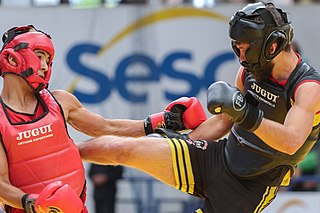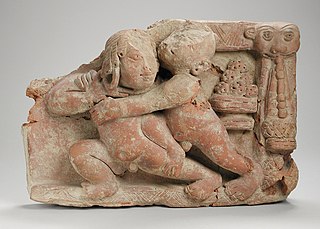
Martial arts are codified systems and traditions of combat practiced for a number of reasons such as self-defence; military and law enforcement applications; competition; physical, mental, and spiritual development; entertainment; and the preservation of a nation's intangible cultural heritage.

Filipino martial arts (FMA) refer to ancient and newer modified fighting methods devised in the Philippines. It incorporates elements from both Western and Eastern Martial Arts; the most popular forms of which are known as Arnis, Eskrima, and Kali. The intrinsic need for self-preservation was the genesis of these systems. Throughout the ages, invaders and evolving local conflict imposed new dynamics for combat in the islands now making up the Philippines. The Filipino people developed battle skills as a direct result of an appreciation of their ever-changing circumstances. They learned, often, out of necessity on how to prioritize, allocate and use common resources in combative situations. Filipinos have been heavily influenced by a phenomenon of cultural and linguistic mixture. Some of the specific mechanisms responsible for cultural and martial change extended from phenomena such as war, political and social systems, technology, and trade and practicality.

Mixed martial arts (MMA) is a full-contact fighting sport based on striking and grappling, incorporating techniques from various combat sports from around the world.

Bōjutsu is the martial art of stick fighting using a bō, which is the Japanese word for staff. Staffs have been in use for thousands of years in Asian martial arts like Silambam. Some techniques involve slashing, swinging, and stabbing with the staff. Others involve using the staff as a vaulting pole or as a prop for hand-to-hand strikes.

Submission wrestling, also known as submission grappling, submission fighting, or simply grappling, is a martial art and combat sport that focuses on ground fighting and submission techniques. It is a hybrid discipline that incorporates elements of various martial arts such as various wrestling styles, judo, and Brazilian jiu-jitsu. Submission wrestling is practiced both as a competitive sport and as a training method for self-defence and mixed martial arts (MMA).

Sanda, formerly Sanshou, is the official Chinese kickboxing full-contact combat sport. In Chinese Language, "Sanda" originally referred to independent and separate training and combat techniques in contrast to "Taolu".

Banshay is a weapon-based martial art from Myanmar focusing primarily on the sword, staff and spear. Influenced by both Indian and Chinese sources, it is closely related to similar Southeast Asian systems such as Thai krabi krabong, Cambodian kbach kun boran and Malay silat.

Lethwei or Burmese boxing is a full contact combat sport originating from Myanmar and is regarded as one of the most brutal martial arts in the world. Lethwei fighters are allowed to use stand-up striking techniques such as kicks, knees, elbows and punches, and the use of headbutts is also permitted. Fighters compete bareknuckle, wrapping their hands with only tape and gauze. Disallowed in most combat sports, headbutts are important weapons in a Lethwei fighter's arsenal, giving Lethwei its name of the "Art of nine limbs". This, combined with its bareknuckle nature, gave Lethwei a reputation for being one of the bloodiest and most violent martial arts. Lethwei is the last remaining sport in the world that allows headbutts. Although popular throughout Myanmar, Lethwei has been primarily and historically associated with the Karen people of the Kayin State; the vast majority of competitive Lethwei fighters are ethnolinguistically of Karen descent.

A combat sport, or fighting sport, is a contact sport that usually involves one-on-one combat. In many combat sports, a contestant wins by scoring more points than the opponent, submitting the opponent with a hold, disabling the opponent, or attacking the opponent in a specific or designated technique. Combat sports share a long history with the martial arts.

Ground fighting is hand-to-hand combat which takes place while the combatants are on the ground. The term is commonly used in mixed martial arts and other combat sports, as well as various forms of martial arts to designate the set of grappling techniques employed by a combatant that is on the ground. It is the main focus of Brazilian Jiu-Jitsu and is featured in varying amounts in Catch wrestling, Judo, Jujutsu, Sambo, Shoot wrestling, Dishuquan Dog Kung Fu, some schools of Shuai Jiao and other styles of wrestling.
Indian martial arts refers to the fighting systems of the Indian subcontinent. A variety of terms are used for the English phrases "Indian martial arts", deriving from ancient sources. While they may seem to imply specific disciplines, by Classical times they were used generically for all fighting systems.

A knee strike is a strike with the knee, either with the kneecap or the surrounding area. Kneeing is a disallowed practice in many combat sports, especially to the head of a downed opponent. Styles such as kickboxing and several mixed martial arts organizations allow kneeing depending on the positioning of the fighters. Knee strikes are native to the traditional Southeast Asian martial arts and traditional Okinawan martial arts.

Malla-yuddha is the traditional form of combat-wrestling originating in the Indian subcontinent. It is closely related to Southeast Asian wrestling styles such as naban and is one of the two ancestors of kushti. Indian wrestling is described in the 13th century Malla Purana.

Bando is a defensive unarmed martial art from Myanmar. Bando is sometimes mistakenly used as a generic word for all Burmese martial arts, but it is only one martial art; Burmese fighting systems collectively are referred to as thaing.

Pongyi thaing is a Burmese martial art created by the monk Oopali in the 9th century. Based on the Hindu-Buddhist principle of non-violence and non-aggression, its objective is not to cause maximum harm but simply to defend oneself. The word pongyi means monk and thaing is an umbrella term for Burmese martial arts.

Although the earliest evidence of martial arts goes back millennia, the true roots are difficult to reconstruct. Inherent patterns of human aggression which inspire practice of mock combat and optimization of serious close combat as cultural universals are doubtlessly inherited from the pre-human stage and were made into an "art" from the earliest emergence of that concept. Indeed, many universals of martial art are fixed by the specifics of human physiology and not dependent on a specific tradition or era.
The traditional martial arts of the Mainland Southeast Asia are related to one another, and as a group to Indian martial arts. The most salient common feature is Mainland Southeast Asia kickboxing. The region of Mainland Southeast Asia is believed to be the land of Suvarnabhumi that ancient Indians mentioned in Buddhist text and Hindu text. In 790 A.D., a Khmer prince who grew up abroad by the name of Jayavarman II returned to unify the Khmer civilization. In 802 A.D., Jayavarman II established the Khmer Empire, the precursor to modern Cambodia, and declared himself the Chakravatin. Around 850 A.D., Pagan, the ancestor of modern-day Burma, was established by Tibeto-Burman speakers. For 200 years, Pagan remained a small principality until the reign of King Anawrahta. In 1238 A.D., Thailand's first state, Sukhothai, was started when the residents declared independence from the Khmer Empire. In 1353 A.D., Laos's first state, Lan Xang, was started by Fa Ngum with the assistance of the Khmer from Angkor.

Kyin is a form of wrestling from Myanmar. It is practiced by the Rakhine people, a minority group in Myanmar. It is practiced in Rakhine State. Tournaments of this sport are usually held during big occasions, for example, Rakhine State Day events.
Myanmar has a number of traditional games, sports, and martial arts. Some of these games were designed to teach people how to protect themselves and their communities.

















